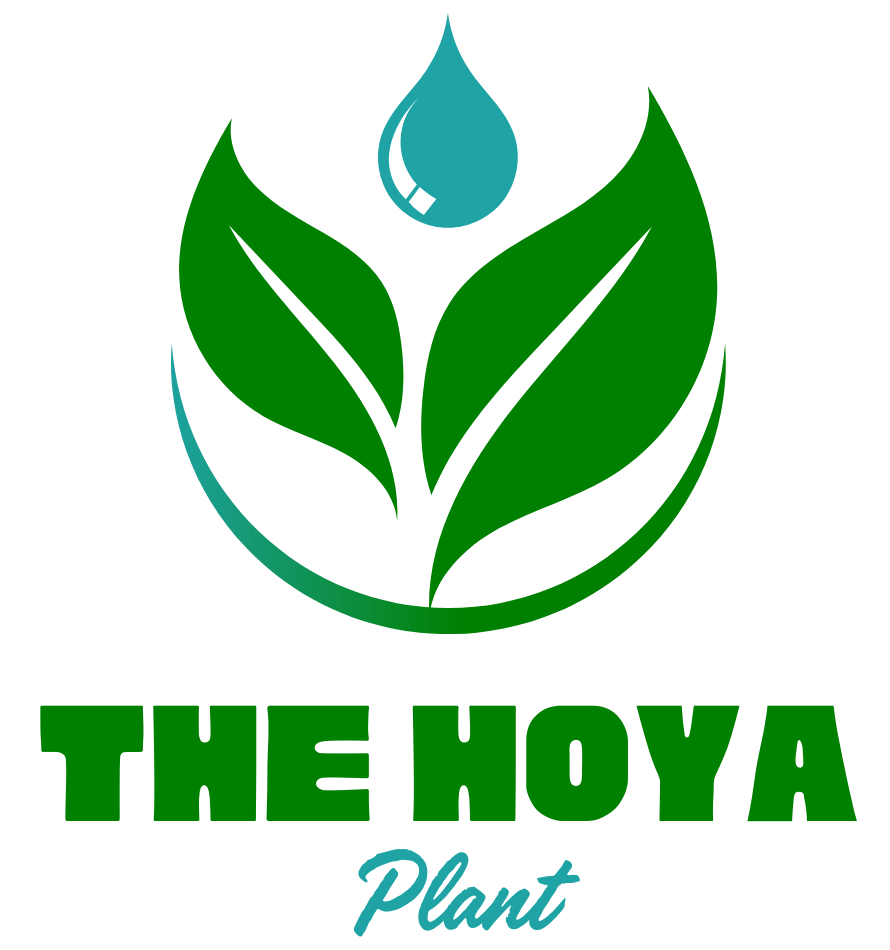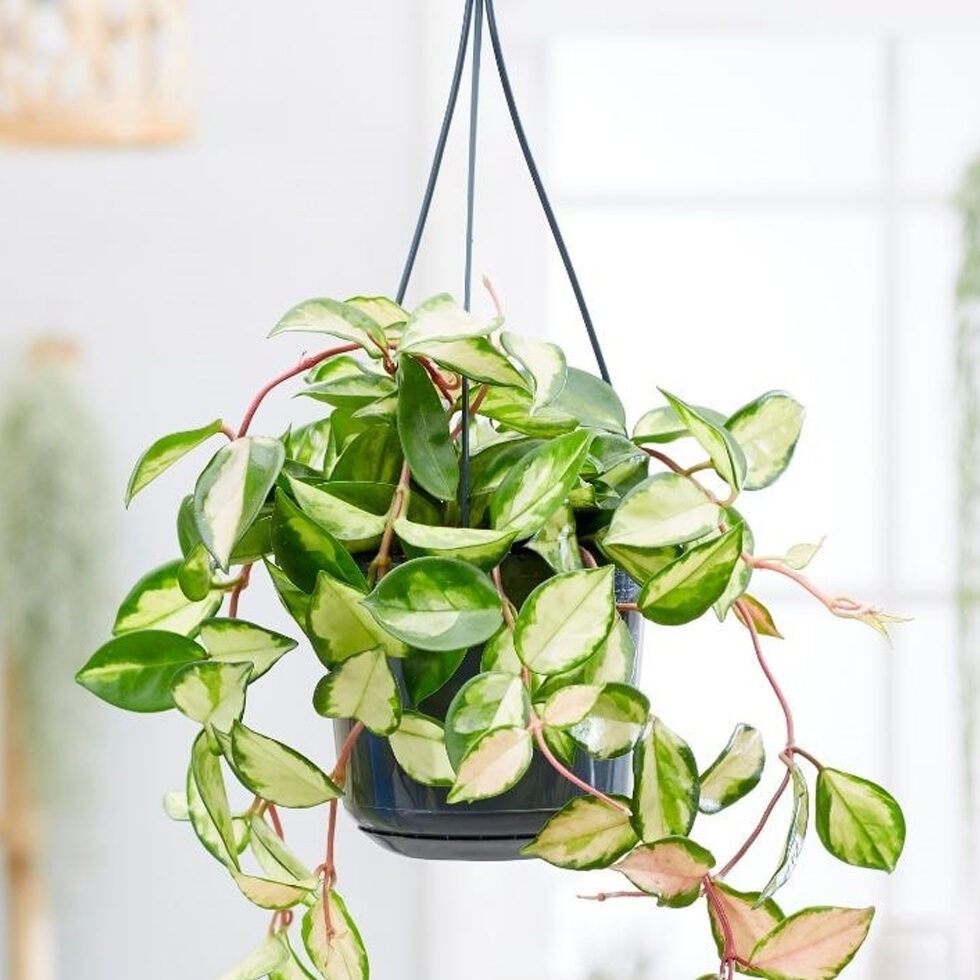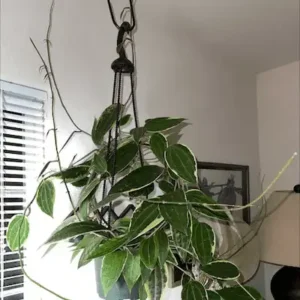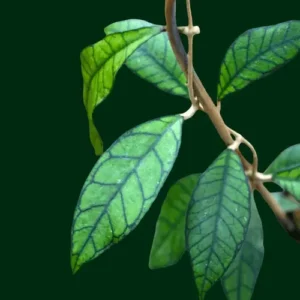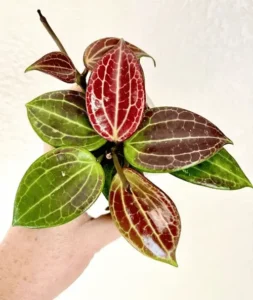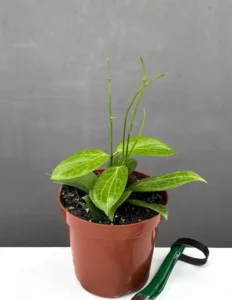Scientific name: Hoya Carnosa ‘tricolor’
Common name: wax plant, honey plant, porcelain flower
Light requirements: bright, indirect light
Temperature requirements: 60°F and 85°F(16°C – 29°C)
Humidity: The humidity level should be around 90-100% to provide the balancing act after striking the cuttings
Propagation: by stem cutting ( choose water or soil method)
Description
Hoya Carnosa ‘Tricolor’ is a lovely training plant that has thick, waxy-textured leaves with varying patterns of pink, cream, and green. This beautiful tricolor houseplant also produces clusters of soft pink blooms with an aroma akin to honey if grown in a light position. It looks beautiful when the stems trail over the edges of a shelf or fireplace.
Facts
-It will tolerate low light, but be much happier in a warm, sunny spot. When it comes to watering.
-This houseplant is a succulent, stem-rooting climber up to 2 meters tall, with stiff, meaty, mid-green leaves that are pink when young and splattered with cream. It’s quite colorful and grows to a large size.
Benefits
-It has air-purifying abilities.
-A source of tranquility, peacefulness, and relaxation, and also helps in lowering blood pressure which are the distinctive benefits.
-It also serves as a living piece of art with its abundant variegated leaves.
it is relatively easy to care for and the best hoya plant for indoor gardening.
Other benefits
-The Hoya plant’s filtering system makes it simple to add oxygen to the air in your house while eliminating carbon dioxide. By removing carbon dioxide and introducing fresh oxygen, your home’s air quality will improve, which will benefit your learning, productivity, and emotional well-being.
-With a steady release of water vapor throughout the day, the Hoya carnosa ‘tricolor’ can readily raise the humidity in your home. You can work more efficiently and get a better night’s sleep with the additional humidity.
-Allergy sufferers may greatly benefit from the increased humidity and better air quality provided by Hoya’s natural filtering system.
-Hoya carnosa tricolor is an excellent houseplant for novices as well as avid gardeners. It also adds antique and modern style to your home.
-Despite its health advantages, it is ideal for pet-friendly homes since it may be a wonderful addition to your house.
Propagating tips
Here are some general tips for propagating hoya carnosa ‘tricolor’ by stem-cutting (choose soil or water method).
Propagation by stem cutting
-Make sure you take your cuttings from softwood. Always take cuttings at an angle using clean, sharp pruners used a popsicle-making container (fancy propagation equipment!) for the rooting because it held the leaves up above the rim.
-Keep water in the container just above the bottom node and when the roots appear, make sure they’re covered too and remove all leaves, those at the top of shorter stem cuttings (no more than 1, 2, or 3 nodes) while rooting in a mixture.
flowering and blooming tips
Here are some flowering and blooming tips for hoya carnosa ‘tricolor’ that you should follow.
Provide the right conditions
The foliage of hoya plants are gorgeous and when you get flowers it’s very special. if you want to get your hoya to flower, provide the right conditions for blooming. Sometimes market -nutrients also matter.
Light requirements
Sometimes hoya is not blooming due to not enough light, so if nothing else, just increase the brightness of light to unlock the hoya to bloom.
Provide Cold periode
-Stress is good for flowers as it encourages blooms such as cold periods or bare patches. popular hoya carnosa often require a short dry period to trigger flowering such as a month of drying out.
-If your hoya is not growing leaves,stay on a good vegetation fertilizer. Provide the best food at the right time.
Improve the underlayers
-Improving the underlayer is often suggested if your hoya is not blooming.
-Don’t remove hoya flowers after blooming
-Don’t remove hoya flowers after blooming, they will drop off themselves. However, it’s necessary to leave the peduncle on.
Reporting tips
Here are some general reporting tips for hoya carnosa ‘tricolor’.
Give a chunk mix to hoya carnosa tricolor
-While reporting, give your plant a chunky mix. By doing this you will always retain your hoya.
-Just disturb your hoya as little as possible. Don’t bash the old dirt off, just drop it in the new pot backfill it with your latest mix, and let it grow.
Doesn’t get all the soil out
-While reporting doesn’t get all the soil out, it will be problematic as hoyas hate their roots being disturbed and root rot is always a risk. If you think that old soil will kill them, in this case, get out soil otherwise don’t take risks.
Other cases of reporting hoya carnosa ‘tricolor’
Here are some other ways of reporting a hoya carnosa ‘tricolor’.
-When you get a plant, leave it to harden off and confine, and see if it’s happy. if it’s growing, don’t report it unless required. After one month if you notice that it stops growing, in that case, get out all the soil, wash or rub the pot with alcohol or some other detergent, and try to be very careful with the roots.in another case, if you don’t want to disturb your hoya then just pot up the size or try to get the soil off the roots.
-If you see the roots coming out of the pot or through the drainage holes and if the plant is drinking water too quickly, in this case, report it.
Insects, diseases and other common problems
Here is the list of insects , diseases and other common problems related to hoya carnosa ‘tricolor’.
Dark spots
Dark spots on the leaves are fungal infections caused by overwatering might be caused by temperature fluctuation. The plant was harmed by these dark patches as they progressively formed.
Aphids, spider mites, and mealybugs
The hoya plant is harmed by mealybugs, spider mites, and aphids. Root rot may result from the container holding too much water if the plant is not kept root-bound. Additionally, overwatering may prevent the plant from flowering.
Thinning, brown, or wrinkled leaves can mean that the plant is allowed to dry too much between watering.
Other common problems
Mold and fungus
-Mold and fungus which are the silent invaders’ discoloration or powdery spots on leaves are also common problems. It is also susceptible to a range of common ‘sap-sucking’ houseplant pests including aphids, mealybugs, scale and spider mites.
-Hoya fungle leaf spot and other fungle or bacterial diseases commonly affect this type of plant which is caused by brown spots on the leaves.
Root rot
Root rot is a common disease caused by overwatering and poor drainage.
Yellow or wrinkled leaves
Hoya carnosa ‘tricolor’ Leaves turn yellow due to overwatering and lack of light.
Wilted, wrinkled, orshriveled leaves are frequently signs of a serious water deficit. Water your plant adequately to ensure healthier development in the future.
Sooty mold and other fungal infections
-Yellowing, leaf spots, excess water on top leaves, sooty mold(develops on the leaves’ sugary, sappy leftovers), light and temperature angles, scale insects, pests and root rot which are the silent killers and occur when the soil is too moist.
-Among the insects drawn to these species are whiteflies. Root rot and leaf drop can result from overwatering. These are all the common “sap-sucking” insects in the garden.
-Caterpillars, spider mites , leafhoppers, yellow edges, dark blotches, leaf beetles, mealybugs, thrips and aphids are also common problems.
Care tips
Although hoya plants are relatively low-maintenance houseplants, they can suffer from a number of common issues, including pests, overwatering, underwatering, and low humidity. Many problems can be avoided by closely monitoring their environment and care requirements. Recognize issues early on and make changes to restore your hoya’s health. Hoyas create lovely, blooming houseplants when given the proper care guide.
Here are some general tips, for caring hoya carnosa ‘tricolor’.
Choose the suitable pot
-Firstly, choose the right pot which is very important, regular plastic containers are best.choose manageable pot according to the hoya size.
-Secondly , choose the material that draws moisture from the soil as hoyas are badly affected by overwatering and root rot.
Care tips to prevent leaf spots, dark spots and root rot
In case of leaf spots
To prevent leaf spot infections, avoid overwatering and ensure the plant has good air circulation, keep leaves as dry as possible. Maintain proper pruning of your shrubs and trees to allow for adequate canopy ventilation.
In case of dark spots
-In case of dark spots apply cinnamon and other fungicide, minimize watering and let your plant to grow. For better growth, longer watering intervals are a must for these beautiful houseplants.
In case of root rot
-Make sure the soil drains well and the plant isn’t overwatered to avoid root rot.
In case of wrinkling, yellowing, and falling off leaves
-To prevent yellowing, wrinkling, or dropping off leaves and scale insects, isolate the plant and spray it with fresh water and rubbing alcohol.
-To avoid yellowing or wrinkled leaves, the best way is to water the plant moderately.
-Provide enough humidity and light to your houseplant for enough growth. Indirect sunlight is very beneficial for blooming this plant.
-If you place this plant at a place where direct bright sunlight comes, leaves will automatically turn yellow.
-To avoid all the above issues, replace the soil with fresh and clean soil. Once you have thoroughly cleaned the plant, it will automatically grow better.
In case of mold and fungus
-To prevent mold and fungus cover and scrub the affected area with bleach, a fungicide, a detergent, or water and then dry it.
-Before remodeling, remove any residue from the cleaning chemical mixture and thoroughly dry the surface of the room where the houseplant is kept.
-Use air conditioners and dehumidifiers to lower the amount of moisture in the air. Keep the humidity inside your home at or below 60%.Insulate cold surfaces including windows, floors, and outside walls to lessen condensation.
-Dry damp areas in a day or two to prevent the growth of mold.
In the case of aphids, mealybugs and spider mites
-Use neem oil, check plants frequently, keep leaves clean, apply rubbing alcohol, steer clear of overwatering, and introduce natural predators to ward off aphids, mealybugs, and spider mites.
-Aphid infestations can be avoided by maintaining target plants well-watered, fertilized, and healthy, as well as by eliminating host weeds and neglected stressed plants. Aphid infestations originate locally, aphids can be sprayed with organic garlic and chili sprays, squished with fingers and thumb, or eliminated from plants with a water jet.
-Most “soft” insecticides and biological agents, which are easily accessible to home gardeners, can be used to control mealybugs.
–Leptomastix dactylopii and Anagyrus fusciventris are two parasitic wasps that can be released into an affected area to suppress mealybug populations effectively.
FAQs Is the Hoya carnosa ‘tricolor’ the best indoor plant? Yes, because of its quick growth and ability to produce stems in a few months, this kind is thought to be a popular choice for indoor gardening. It is a low-maintenance and easy-going plant. Are hoya plants poisonous to cats and dogs? No, the hoya plants are not poisonous to dogs and cats, just love and treat them as regular houseplants. They are pet-friendly. How often to water the hoya plants? Although they enjoy being wet, hoya plants also prefer to be dry at the same time. After giving the soil a thorough watering, allow it to dry up before applying more water. However, during flowering, they require more water. |
Conclusion
The Hoya Carnosa Tricolor, with its stunning mix of green, cream, and pink hues, is a beautiful and hardy plant that brings a touch of elegance to any space. Its ease of care, including its tolerance for low water and indirect light, makes it a popular choice for both novice and experienced plant enthusiasts. Beyond its aesthetic appeal, this plant contributes to a calming environment with its air-purifying qualities. Whether displayed in a hanging basket or as a climbing vine, the Hoya Carnosa Tricolor stands out as a charming and rewarding addition to any plant collection.
